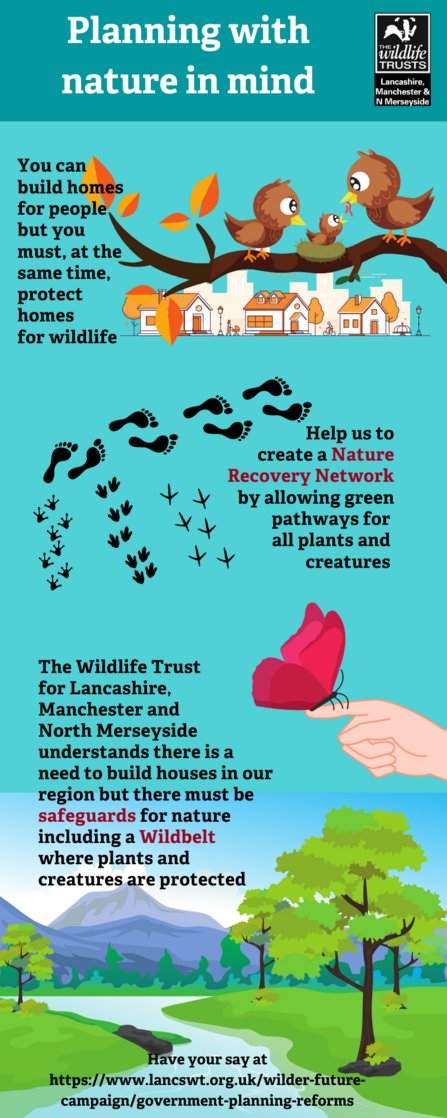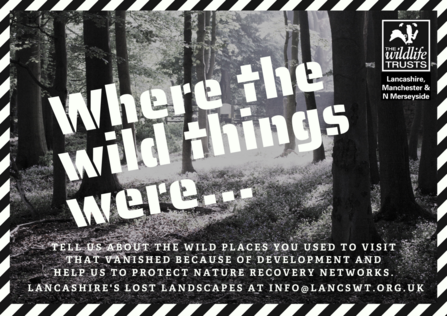The Wildlife Trust for Lancashire, Manchester and North Merseyside is calling for an end to planning that means the devastation of wild creatures and plants in the 21st Century.
And they are supporting the national Wildlife Trusts in calling on the Government to commit to five principles to be applied to future planning which would ensure the reforms can address the climate and ecological crises and people’s need for nature around them.
One of these principles would, for the first time, protect new land put into nature’s recovery. For this, The Wildlife Trusts propose a new protection mechanism called Wildbelt.
Craig Bennett, chief executive of The Wildlife Trusts, says:
“We’re in a climate and ecological crisis and we cannot afford to lose any more wildlife – we need a new Project Speed for nature. We must keep the environmental protections that we have – but even that is not enough. Protections must be strengthened, and the Government needs to take a big step towards helping nature to recover everywhere. The new planning reforms currently propose an algorithm-based system that’s dependent on non-existent data. That’s a system that will fail nature and lead to more loss.
“Evidence shows that healthy communities need nature and the government must map out a Nature Recovery Network across every one of their proposed zones, whether it’s a growth, renewal or protected area. We’re proposing five principles to ensure the planning system helps nature and we want to see a bold new designation which will protect new land that’s put into recovery - we’re calling this Wildbelt.”
The Wildlife Trusts’ five principles are:
- Wildlife recovery and people’s easy access to nature must be put at the heart of planning reform by mapping a Nature Recovery Network
- Nature protection policies and standards must not be weakened, and assessment of environmental impact must take place before development is permitted
- Address the ecological and climate crises by protecting new land put into recovery by creating a new designation - Wildbelt.
- People and local stakeholders must be able to engage with the planning system
- Decisions must be based on up-to-date and accurate nature data
Lancashire Wildlife Trust Chief Executive, Anne Selby said:
“We need people who love nature and those who have re-engaged with nature during the lockdown to support our campaign and for the creation of the Wildbelt.
“We need to stop the attacks on the diversity of our wildlife and ensure that any planning includes room for nature to recover, not just here but in networks across the United Kingdom.”
Campaigns Manager Alan Wright said:
“We want a Wildbelt that is protected from development. We want modern answers to how development should progress, not 19th Century answers involving building for the short-term and then leaving society to deal with the consequences afterwards. And we want reasonable arguments for development and a voice in the decision-making process, not populist myths about scything through “red tape”.
“It’s easy to demand more house-building and blame newts for getting in the way of progress. Is this entirely true? The reason half a million houses haven’t been built, despite having planning permission, is down to the structure of the UK’s housing market, not a great crested newt found in a nearby pond.
“And it certainly cannot be business as usual: as we are learning to our cost, if you kick the environment it can kick back harder. This is a global problem so we all need to make a difference.”
The UK is one of the most nature-depleted countries on the planet and the government has committed to reversing wildlife declines. A successful planning system is crucial to securing the recovery of nature and creating healthy communities with natural green space on people’s doorsteps, no matter how dense the housing. However, The Wildlife Trusts, who respond to thousands of planning applications every year and are taking part in the White Paper consultation, believe the new Government proposals will make a bad situation worse.
To find out more here. The deadline is 29th October 2020.


